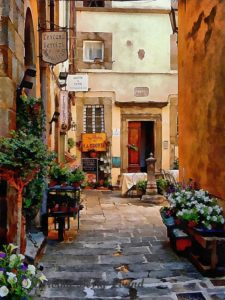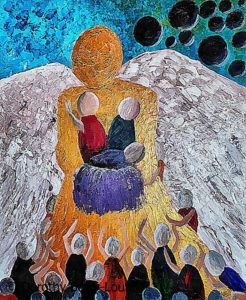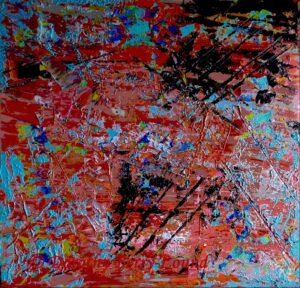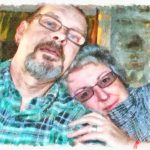
I stepped outside my comfort zone in a very literal sense with my new abstract artwork. Literally pushing myself physically to create art. I think it was worth it! Read on and find out what I have been up to.
I Stepped Outside My Comfort Zone
Photo Art

As a photo art specialist, I am very comfortable with creating images based on my photographs. For example, my images of Central Italy where I live. I love finding a view and then working on it to create as sense of feeling in the piece. How it feels to be there, if you like, not just what I can see with my eyes.
Acrylic Painting

I have also always painted in my studio here at the house. It used to be a hobby to aid with de-stressing from the day job. Once I retired a few years ago, the painting became another pillar of my art work. Sometimes I use it to get down how I feel about things that are going on in the world. That is certainly the case with my painting ‘Protect The Children’. I wrote a blog about my long process creating this piece.
Acrylic Pours

But in the last year I have also developed an interest in creating abstract work. For example, my work with acrylic pours has been very enjoyable and I have been delighted with the results. Like the image above called Purple And Pink Dip Fantasy 2. I wrote a blog on creating this particular piece.
However, I wanted to push my abstract work a bit further. I saw a YouTube video by an artist called Inga Knaak that really fired my imagination. But the technique looked quite physical and I wasn’t sure, suffering from Fibromyalgia, that I could actually do it!
Abstract Art Using Builder Tools
A New Technique For Me
The technique I wanted to try involved building up layers and layers of paint using what Inga calls a ‘Squeegee’. I think it would also be known as a plastering tool, a skimming tool or a finishing trowel. You may call it something else (let me know in the comments)?
This is not as simple as it sounds of course. The colours used need careful thought, as some can swamp the others. A hair drier comes in useful for drying some of the layers to stop some of the paint blending together. Otherwise there is a danger of colours overmixing and going muddy. The technique involves layering paint onto the trowel and then dragging it across the surface of the canvas. The canvas is turned at regular intervals so that you are going in different directions which helps build up the textured surface.
The first problem I hit was the size of the trowel I wanted to use. It was a standard finishing trowl but was, literally, too big for me to manage. A combination of Fibromyalgia and arthritis in my hands meant I had no real control over the tool.

However, as you can see, Barnet Boy found a smaller tool that I could just about manage.
My First Attempt
The first abstract I produced nearly finished me off! The technique is so physical! I stepped outside my comfort zone and really regretted it at one point. The effort of dragging the tool across the canvas, whilst holding onto the canvas with other hand so the tool could glide was hard for me. This had to be done standing of course which was another issue. Layer upon layer of different coloured paint. Constant cleaning of the tool and the twisting and turning I needed to do really took a toll. I hasten to add that for someone in good health I can’t see this being a problem. But I wouldn’t know good health if it bit me!

I reached a point where I really thought I couldn’t go any further and I was almost in tears with the effort. After a long break and chatting online with some artist friends who really encouraged me, I finally went back to finish the painting. I am so glad I did as I am pleased with the result! Whether it was worth me then spending the next three days recovered is another matter. Based just on that experience alone I was tempted to never try this again. But I am made of sterner stuff! After a week I was determined to find a way to do this without killing myself in the process!
My Second Attempt
When I came to do the second one, based on my initial experience, I was able to work much smarter and get everything prepared. By now I knew what would work and what wouldn’t. I knew how not to use the trowel and the whole painting process was much smoother as a result.

I had figured out the first time how to create more of a textured effect which was what I was looking for. I also broke the painting down into several stages over a couple of days which allowed me some recovery time. It was still tiring and ache producing but it was much more manageable. I stepped outside my comfort zone. And I love the final result, don’t you?
Now all I have to do is wait for the second one to completely dry and then I can scan both new pieces and get them uploaded to my online stores for sale as prints!
Before you go

My name is Dorothy Berry-Lound an artist and writer. You can find out more about my art and writing at https://dorothyberryloundart.com.
You can follow me on Facebook.
Thank you for reading!

Looks like a lot of fun – i’ve always wanted to try Gyotaku – Japanese fish painting. maybe someday i will (& besides you get to eat your fish afterwards)
Do you know Steve, I had never heard of that and had to look it up! Yes it was fun to make those abstracts but, as I said, quite hard work. I was so pleased with the outcomes though. Thanks for your comment.
My husband has “fibromyalgia-like symptoms” so the fact you made a second painting tells me just how much you liked the first one!
Exactly! I knew I could make it work easier for me, and I like the outcomes. Thanks for your comment (and a hug for your husband from a fellow sufferer).